This is the first person account of a young Pilot Officer caught in the thick of a frontline battle at Chhamb. Plt Offr H K Bajaj 12762 F(P) was a newly commissioned officer sent to 10 Div area as a Forward Air Controller. This is his blow by blow account of the war on the ground.
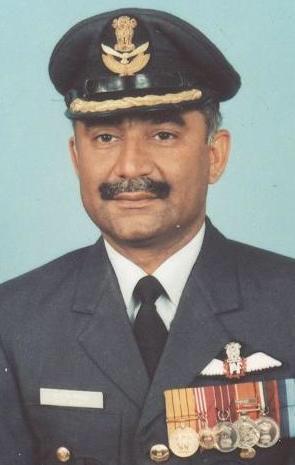 This is the first person account of a young Pilot Officer caught in the thick of a frontline battle at Chhamb. Then Plt Offr H K Bajaj 12762 F(P) was a newly commissioned officer sent to 10 Div area as a Forward Air Controller. This is his blow by blow account of the war on the ground.
This is the first person account of a young Pilot Officer caught in the thick of a frontline battle at Chhamb. Then Plt Offr H K Bajaj 12762 F(P) was a newly commissioned officer sent to 10 Div area as a Forward Air Controller. This is his blow by blow account of the war on the ground.
Authors Note: The recount given below is more like my autobiography of those fourteen days of the War (December 71). It includes only what I personally experienced, witnessed & now recall of those days, after nearly half a century! Yes, to maintain flow, I have included a few facts, figures & sketches (depicting deployment) taken from the write-ups of a few eminent defence experts, IAF history sheets (references below) & my pocket diary of 71 War which I still have; but those too, I have included to the extent I agree that might have happened / prevailed at that time! I have also, very humbly attached a firsthand account (as provided by then, Flying Officer (Fg Offr) BC (Lofty) Karambaya) of an air battle (2 Vs 2) of then, Squadron Leader (Sqn Ldr) RN (Mummy) Bhardwaj & then, Fg Offr BC (Lofty) Karambaya with two enemy Sabres (Appendix-D); four extracts from the War Diary of Lightning Squadron (20 Sqn) giving details of Close Air Support (CAS) missions flown by their Squadron (Sqn) for the Battle of Chhamb (Appendix-E); and a photo copy of a photograph of `Falcons of Chhamb’, Indo Pak War Trophy – 1971’ as provided by then, Flight Lieutenant (Flt Lt) Gurdeep Singh of 101 Squadron, (Appendix-F). It shall be an honour & I would look forward to addition of any personal experience(s), correction(s) or variation in flow of the events as might have then taken place. Lastly, with specific permission & due credit to the writer, I shall like to add your inputs to this short story.
By Gp Capt HK Bajaj, VSM (Retd)
Version Updated: Sunday, 22 November 2020 11:48
`The Life-Lines Don’t Change!’ – My Induction into 71 War
On 12 June 1971, a pair of `thin strips’ of Pilot Officer (Plt Offr) rank were unveiled on the shoulders & IAF Wings were pinned on the proud chest of each Passing Out air force cadet of Flying branch of 106th Pilots’ Course (PC). The excitement was such, that given a chance, we would have even loved to sleep in uniform with P Caps on! Yes, morale was sky high!
After a month’s leave, when we joined OTU Jamnagar, 104th & 105th Pilots’ Courses had yet not completed their conversion training on Hunter ac. With war clouds on horizon, our Course was extensively trained by then Wing Commander MS (`Minhi’) Bawa (later Air Marshal MS Bawa, C in C (Retd)) in Forward Air Controller’s (FAC) role.
The excitement peaked in September 71, when our Course, vide P/209 dated 10 Sep, was attached to Air Headquarters (Air Hqs) for two months. With a suitcase full of `suits-boots & ties’ and a bed-holder, I landed up in Delhi. The next day, we were issued a Revolver & 24 live rounds each and some of us were flown out to Udampur, 4 Tactical Air Centre (TAC) AF, commanded by then, Gp Capt (later Air Mshl, C in C) K.I.S Chhabra (TAC Cdr). After two weeks of extensive ground training and air exercises, we were attached to different Brigades / formations of 15 Corps. On 25 Sept, I, with a GU 734 R/T set & a `Satpal Light’ (an aid to assist pilots (fighter aircraft) to spot ground targets), landed up in a bunker with 5 Sikh / 191 Infantry Brigade at Chhamb. I was subsequently attached to 68 (I) Inf Bde, the Corps reserve, meant for the offensive & located at Akhnur.
On 03 Dec 71, when the balloon finally went up, a few of us (FACs) were at Udampur; and in an air exercise, we had checked all our equipment, radio sets, the frequencies, Contact Points (CPs) etc. In the evening, we all, watching a Hindi movie (Paaras) at Army auditorium, Udampur, were asked to report back to our Operational Units immediately. Yes, the War had started! Our `One-Ton ride’ back to Akhnur, in loud, continuous sound of heavy artillery (arty) fire & the orange glow all along the Western horizon, looked very long & was full of anxiety to reach the scene of action at the earliest (Map – 1)! I along with my FAC team of two RT operators, one Naik (NCO i/c Air Support Signal Unit (ASSU) network / Detachment) and a driver reached the Brigade HQ by late night.
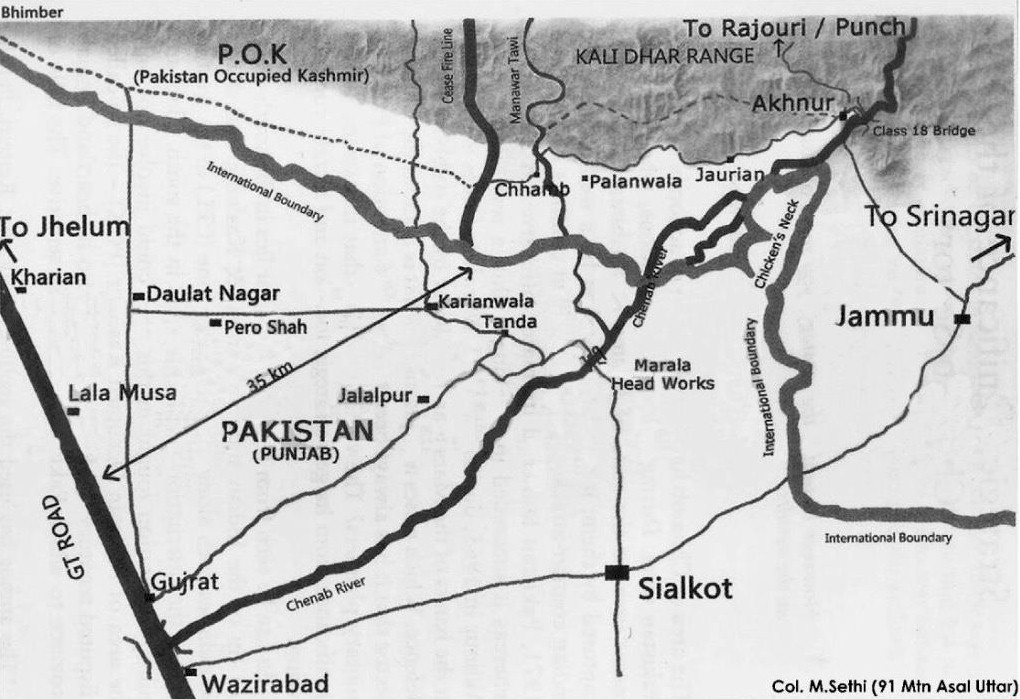
Map 1. Strategic Importance of Chhamb Sector – Jammu-Akhnur-Palanwala-Chhamb Sector
Pakistan army had launched a major offensive in Chhamb salient with four Infantry Brigades, three Armoured and eight Artillery Regiments. The attack in 191 Bde defended sector came through the intentional gaps left in defensive minefields through which 68 (I) Inf Bde group was to have launched their offensive. Yes, in Chhamb area, Pakistan had achieved surprise both at tactical and strategic levels. All forward posts along the cease fire line (CFL) were subjected to intense arty fire & a few of our Border Observation Posts (BOPs) were overrun. Looking at the buildup, on 03rd night itself, 7 Kumaon was ordered to move up and occupy positions at Kachrial heights. However, they were surprised by the infiltrators who had already dug in there. They suffered major casualties, with their Commanding Officer (CO) and three other officers (offrs) being wounded; Three tanks (T-55) of 72 Armd Regt (under Command 68 Inf Bde) were damaged.
The morning of 4th Dec saw our four Hunters over flying Akhnur bridge at tree top heights and heading West on a strike mission. But, although the air force markings were clearly visible, not only our L-60 guns opened up but also the small arms started firing; and a revolver round fell right in front of Brig Tom Morlin, Commander, 68 (I) Bde, having breakfast under a tree! Later, the Commander along with his G3, Capt Chatterjee & self (on insistence & request) with my tentacle vehicle moved to 10 Div Advance HQ at Palanwala for further orders & reinforcement (Map – 2).
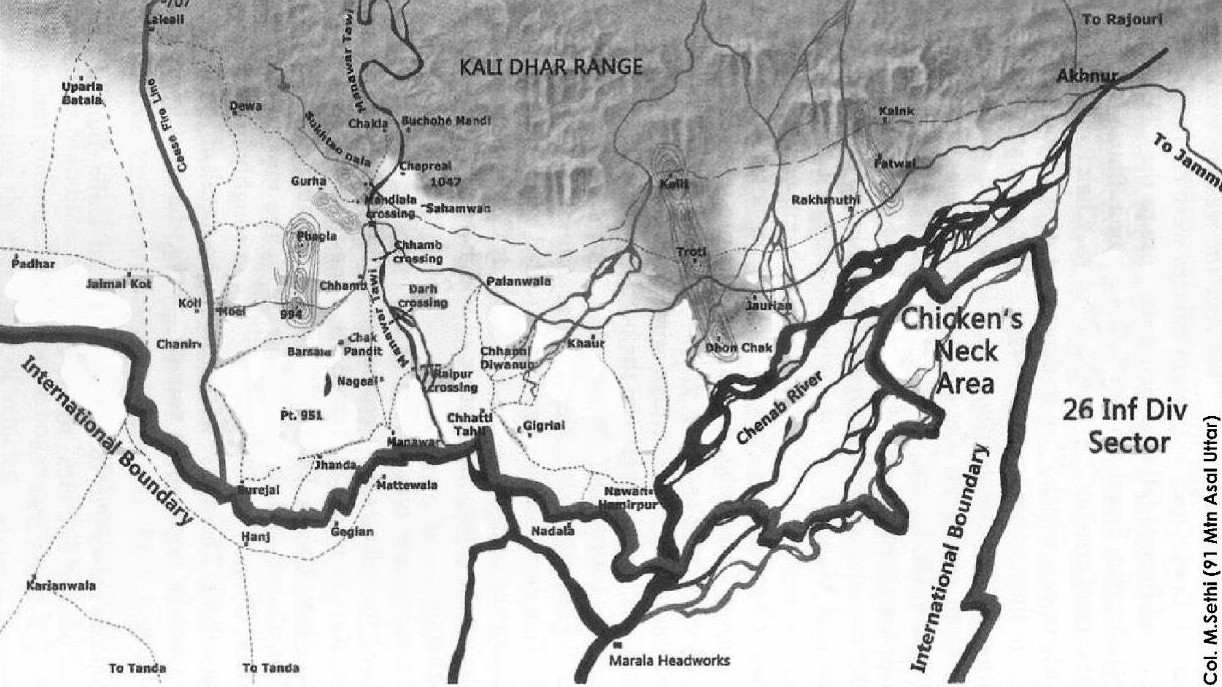
Map 2: Chamb Jaurian Akhnur Sector
En-route, we saw waves of villagers, including, men, women & children of all age groups moving back from the Cease Fire Line (CFL) with their essential belongings; travelling on foot, in carts, buses, cycles & even on buffaloes! One could well imagine the pain, agony & trauma the people would have gone through at the time of partition! It was indeed a very painful sight.
At 10 Inf Div Adv Hqs at Palanwala, Commander took a reinforcement of one Squadron of Armour (T-55) & a Company of 9 Jat. As we moved forward towards the second line of defence on the eastern bank of Manawar Tawi, it was a pleasure to interact with Maj Guleria, Coy Cdr, 9 Jat who was bubbling with enthusiasm & the killer spirit. On our move further, I, for the first time, saw a very seriously wounded battle casualty being taken on an open jeep; & the reality of war was slowly sinking in!
Next, we first came across around 40-50 troops of 7 Kumaon falling back, followed by 3-4 tanks (T-55) retreating. It was all very disturbing. We gathered the men & the Cdr motivated the troops to move back to their defenses. However, when CO 72 Armd Regt displayed reluctance for the second time, the Brigade Commander had to threaten the CO to move; and thus restored the situation. About two km short of the eastern bank of Manawar Tawi, we had an admin halt along with a Troop of three tanks. Bde Cdr then decided to take a tank and visit 7 Kumaon & also look up the Armoured Regiment at Manawar Tawi. The general area being close to our likely area of operational deployment and with positive support of the Troop Commander (a Major from 29 NDA Course), I managed to argue my case & was permitted to follow them in another tank.
Halfway through our move, the Cdr summoned me to his tank. I jumped over and sat on the turret while the Cdr & Tp Cdr stood in the two cupolas. Soon our tank was stopped by a Lieutenant who informed that there were infiltrators just 50 meters on our left and were firing with automatic weapons. As soon as the officer & his team of ten men started firing at the hut in a cluster of trees, the bursts of fire started coming from the other side! As the bullets started whizzing past, the two Cupolas closed; and I found myself prominently sitting alone on top of the tank in my blue flying overall with bright, orange toweled-collar and of course with NO WEAPON! (I had deposited my revolver with our Brigade armoury! Yes; it was a case NO HOLSTER! I had not brought my webbing from Jamnagar; & from the Brigade, I could not get a spare holster!!)! The quick reaction was to jump down & run along the tank taking shelter from its hull. Then, the tank stopped, the turret moved & a tank shell was fired. The hut went up & came down, and there was all quiet!
The young, inquisitive Plt Offr now followed the Cdr to see what was inside the hut! As I was moving through the shrubs, I noticed two bodies (dressed in turbans; – yes, they were the infiltrators in disguise) lying in the approach path. I was about to cross over them when I was stopped by a jawan following me! Yes, that was the second reality of war that I had seen on my first day of induction! In the meanwhile, the Cdr walked out with a walking stick in his hand and gestured, ’How do you like this as a souvenir of war?’ In the situation, my only response was, ‘as long as we last the war, Sir!’ In the cache, we found, two Light Machine Guns, 6-7 Semi-Automatic Rifles & a Chinese communication set! This communication set, for the rest of the duration of war, became the source of entertainment at our officer’s field mess! Commander offered me to pick any weapon for my self defense which I politely declined!
➢ It now occurs to me that had we (Cdr & Self) preferred to travel in our own light Vehicles on this route, we all would have been easy targets for the infiltrators; & `our war’ might have been over then and there; or at least, very different from then on!
➢ Secondly, as it would emerge later in this story that had this enemy position (ambush) not been neutralized (with a tank shell) then, these infiltrators could have caused extensive damage / trouble to the subsequent build up of our forces / to the supply chain, on this axis!
Once at base of the hill (Kachrial heights), still approximately 7-8 km from the Cease Fire Line & less than a kilometre from the eastern bank of the Tawi, we parked along with another 10-12 tanks which were already positioned under a large cluster of trees. It was these tanks which had been attacked by the infiltrators on the night of 3rd December. The Cdr found that though no tank had been destroyed, the three tanks had been externally damaged by the infiltrators. It was the surprise, shock effect & the casualties among the key personnel which demoralized the men; and subsequently, led to moving back of some of the tanks & troops of 7 Kumaon.
Air Attack
These tanks presented an ideal target for an air strike! The Bde Cdr called me to his tank & ordered a quick dispersion of all the tanks. However, the process had yet not started, when we heard Sabres (F-86) overhead and saw the first aircraft already in a dive attack on us! In a very quick move from top of the tank, the Bde Cdr went into a nearby, already overflowing trench; and I laid down in the open.
The first aircraft released its bombs and it appeared as if they were only coming for us! The bombs overshot our position by just about 10 mtrs & exploded. I was literally lifted off the ground. As the dust settled, I realized that it was the same dust that one looks for while firing and makes necessary corrections in the next pass! I looked around and found, all our tank crew were engaging the aircraft with their ack-ack guns. There were total of five aircraft and surprisingly, some were even rolling in from opposite direction; which didn’t look very safe.
Realizing that the targets for all these five Sabres were just the tanks, I ran 50 odd yards away from this area and lay in the open. Subsequently, they strafed us with their six 0.5 inch guns (each). I along with another army officer, who also did not find any shelter, kept a count of all five aircraft and laid clear of their firing path every time! Yes, they had a free hand, attacked us for 20 mins, came very low and in a few cases we could even see the pilot with his helmet!
Fortunately, there was no damage to any of our tanks or personnel! Just the outside slung beddings of two tanks caught fire, which were soon brought under control. I went back to my own tank for the return. But to my surprise, that tank moved to another position and stopped. I ran to board the Bde Cdr’s tank which had already left. I then realized that I had lost my watch during the ‘circus’. (which I found on 18th Dec, lying at the same place!)
Yes, it was a ‘jolting, lifetime experience’ not only for the Commander but even for the young ‘air force lad’ (each one of us) to be in the ‘gun sights’ of five fighter aircraft and yet get away!
By sunset of 04th Dec, then, Plt Offr HK Bajaj had got his first taste of the war; and was well inducted!! From then on, though it was just the beginning & there were many more surprises and close shaves yet to unfold, my belief in the `Destined
Life-Lines’ had been further reinforced!!
Progress of the Battle
On 04th Dec, as it was late, the Cdr did not go up & meet the Kumaonis at their location. We reached the pre-selected site for our Bde HQ; and before last light, we were reasonably established with our Bde Ops room, Air Support Signal Unit (ASSU) network and a few bunkers which were to be our home for the next one month or so. Our location was approximately a km short of Manawar Tawi & 1 ½ km SE of Chhamb bridge. We (the FAC team) established our ground communications (ASSU net work) with our One ton vehicle parked next to the ops room; while the GU 734 (Ground to air comn set) & the ‘Satpal Light’ were kept in the FAC’s jeep. I had NO GLO. However, I was in regular contact with our Ops room, G3 & the Bde Cdr; and thus received periodic updates and the requirement for Close Air Support (CAS).
The officers’ field mess was set up in a six feet wide naallah covered with high sarkanda growth, and our mess Havaldar gathered sufficient livestock from the nearby vacated villages to feed the Cdr and all offrs with well laid out cutlery! The Chinese radio set (captured from the infiltrators on 04th afternoon), with a ‘selected’ radio operator, provided the much needed entertainment & kept the morale high!
GOC 10 Inf Div (Maj Gen Jaswant Singh) had four Infantry Brigades under his command. He deployed 28 Bde in the hill sector, North and North-East of Chhamb from Sunderbani to Laleali down to Dewa; while, 191 Bde held firm base south of 28 Bde in the plains West of Manawar Tawi. 68 (I) Inf Bde (meant for offensive) with its three Bns, i.e. 5/8 Gorkha Rifles (GR), 7 Kumaon, 9 Jat occupied the northern half of east bank of the Tawi; while, 52 Bde (the fourth) was deployed on the southern half of the east bank (Map – 3). 10 Inf Div also had under its command 9 (Deccan) Horse (T54), 72 Armd Regt (T-55), 2 Independent Armoured Squadrons (ex-Central India Horse (AMX-13)), two Engineer Bns, six Regiments of Artillery (two medium, three field, one light), a Coy of 9 Para Commandos, a Coy of 12 Guards equipped with entac anti tank guided missiles (ATGMs) & two Border Security Force (BSF) Bns manning the border.
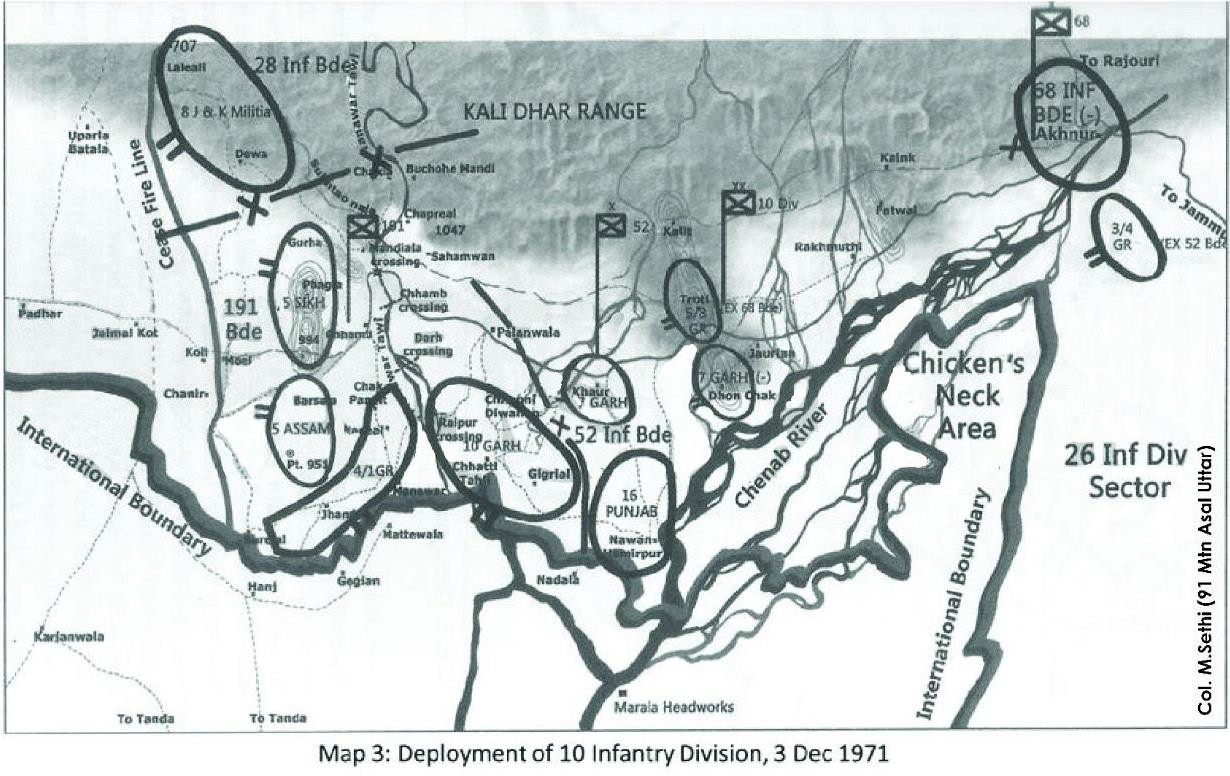
Commander 191 Bde (Brig Jasbir Singh), out of Bde’s four Inf Bns (5 Sikh, 5 Assam, 4/1 GR & 10 Garhwal Rifles) had deployed three Bns which covered the CFL from the Manawar village-Jhanda area in the south to Mandiala in the north. However, in the Barsala-Jhanda area, South-West of Chhamb, through which 68 (I) Inf Bde group was to have launched their offensive, a dummy minefield was left. 10 Garhwal Rifles (Garh Rif), the fourth Bn of the Bde held positions East of Manawar Tawi (Sketch 1 Below).
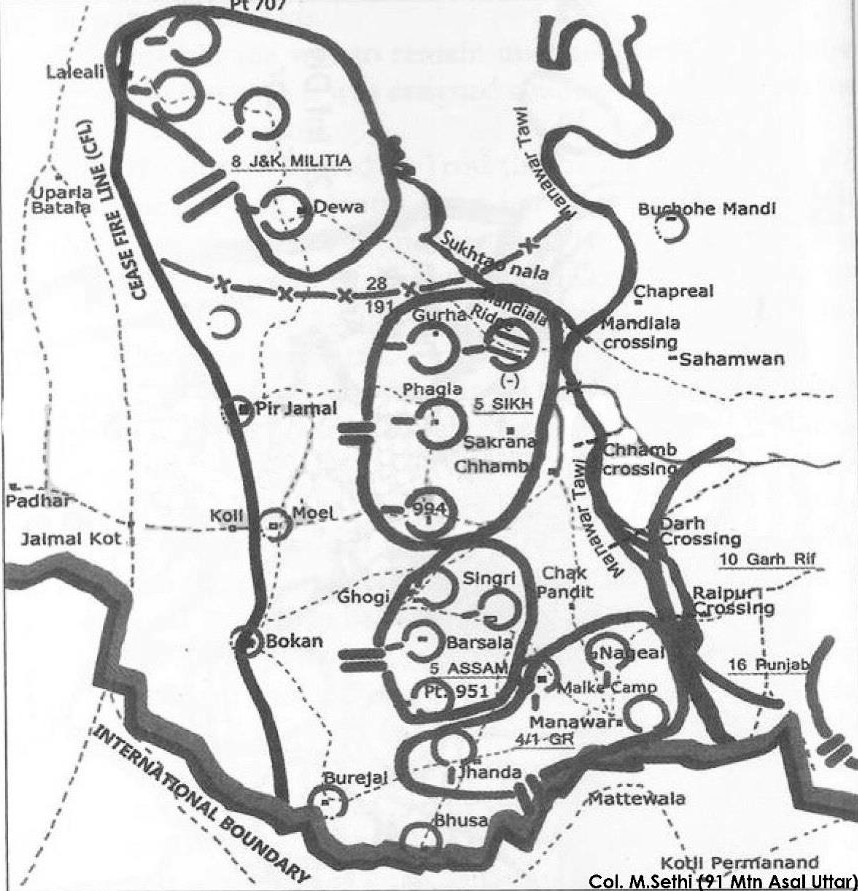
Sketch 1 : Deployment of 191 Brigade on 3rd December 1971
Pakistani forces had a fair estimate of Indian deployment in Chhamb salient. Thus, with the aim to develop a major thrust in the north towards Mandiala (hts) where the opposition was negligible; and to secure a bridgehead near Mandiala crossing over the river as part of the first phase of their operation, the enemy grouped its resources and broadly employed them thus (Sketch – 2):
➢ One Brigade Group in the north to secure Mandiala crossing and establish a bridgehead up to the Kachrial heights.
➢ Second Brigade Group was employed to capture Chhamb and Mandiala heights.
➢ Third Brigade Group to contain the troops deployed from Barsala to Jhanda.
➢ While, the fourth Inf Bde attacked from Jhanda to Manawar in the south.
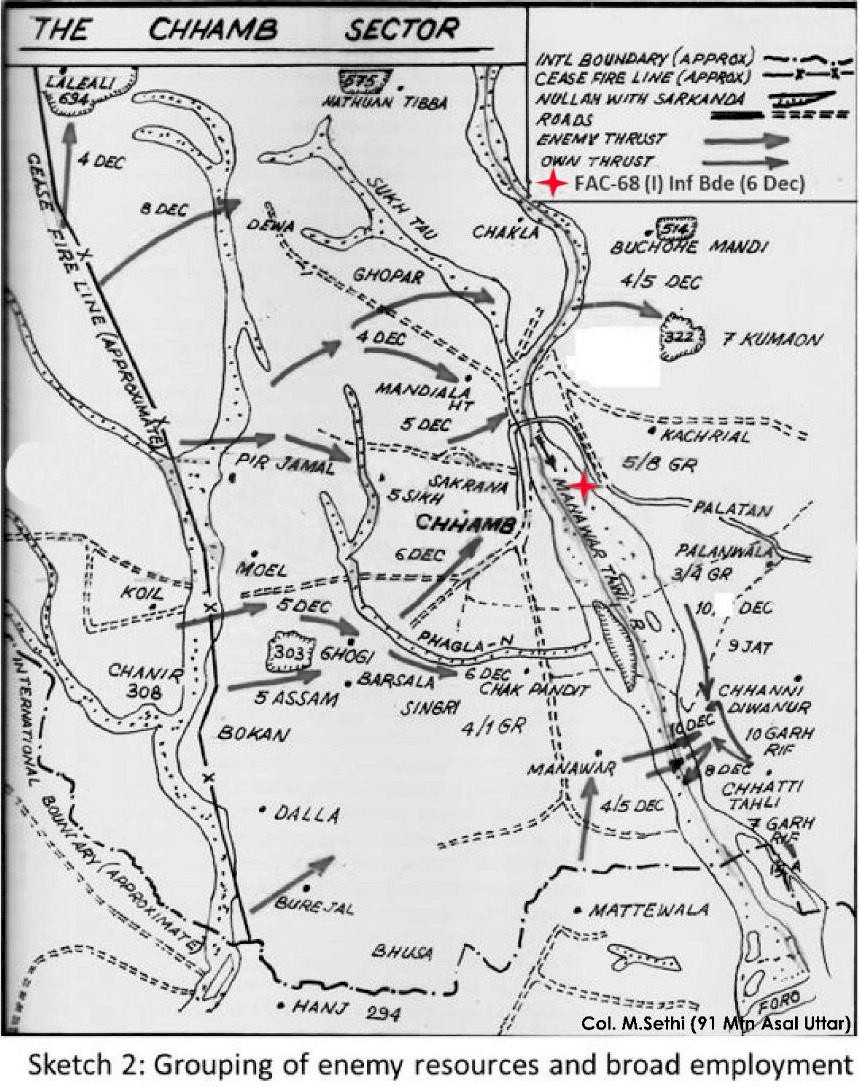
Sketch 2: Grouping of Enemy Resources and Broad Employment
Heavy Artillery fire had continued the whole of 3rd night. To start with, a few of the Forward Defended Localities (FDLs) in 191 Inf Bde Sector had stood their ground stoutly. On 4th morning, 9 (Deccan) Horse (T-54 tanks) and the recoilless (RCL) guns of 5 Sikh blunted a major armour thrust of the en towards Mandiala crossing; and by mid day they had claimed twelve enemy tanks (M-36 Sherman / T-59) & two jeep mounted RCL guns in two different attacks. But enemy pressed home the attack and by the afternoon had captured Mandiala North.
On 04th/05th night a few infiltrators / Razakars also attacked one of our 216 Medium Arty Battery East of Tawi & managed to destroy one Gun and damage another three. In the ensuing encounter 5 / 6 Razakars were killed. Through the night, Pak infiltrators in their khaki uniform, mistaken for DSC personnel, in a surprise move also managed to capture Chhamb bridge. Our troops realized only once they had held a few vehicles & shot their occupants in middle of the bridge.
On 05th early morning, our Gorkha troops of 5/8 GR gave the first morale booster by bringing ‘three Paki heads’ in revenge; cleared the bridge of enemy occupation and thus thawed their attempt to establish a bridgehead. Though 28 Bde, North of Chhamb Bridge, along with elements of Deccan Horse did launch a counter attack but did not succeed in dislodging the en from Mandiala North (just west of the bridge). During the afternoon, en increased its pressure from South & South West of Chhamb; & after repeated attacks, by evening, Mandiala South had also fallen. Thus on 05th night, with Pakistani thrust closing on to the crossing and endangering our troops West of Tawi, it was decided to withdraw from Chhamb and stabilize defenses along eastern bank of the river. The withdrawal of 191 Bde was complete by the midnight & the Chhamb bridge was blown off by the last combat elements of the Bde (12 Field Arty Regt).
Thus, from midnight of 5th/6th December, 68 (I) Inf Bde, deployed East of Tawi, came in contact with the enemy. However, the enemy artillery continued to shell the area West of Manawar Tawi throughout the night. On 05th/06th night, I met Flt Lt VG Kumar (FAC, 191 Bde) at the caravan of Brig Jasbir Singh, Cdr 191 Bde. Though, they all looked fatigued, it was a battle gallantly fought against a very heavily armed enemy. 5 Sikh & all other elements of 191 Inf Bde gp took the brunt, fought valiantly but suffered heavy casualties. (On 12th/13th Dec, they were conferred with many gallantry awards.)
On 04th & 05th Dec, though one could hear our own formations in the air (on counter air / air interdiction or might be on CAS missions West of Chhamb which I could not have seen) but apart from the four aircraft strike (Hunters) that over flew us on 04th morning, I did not see any of our aircraft over the area. On the other hand, on the first day, four air strikes of 4/5 Pakistan Air Force (PAF) aircraft each were reported; while, on 05th & 06th Dec, three enemy formations each, of four / two aircraft struck our tanks, gun positions (216 & 39 Med Regts), Div Hqs & the troop concentrations at Palanwala with very little / no effect.
However, from 07th Dec onwards I did not see any PAF strike aircraft over our area nor was any en air action reported. Further, on 05th Dec, I did raise demands for Search & Strike missions against targets West of Chhamb village but none was accepted. On 05th evening, when Tac Cdr, 04 TAC (then Gp Capt KIS Chhabra) called up to check enemy air activity over our area as also my safety, I did crib my heart out! However, he assured me that I would get a fair share of CAS; which we finally got from 06th Dec onward.
The Falcons of Chhamb
It’s now well known & documented in Air Force history that the `Falcons’ (101 Sqn) flew extensively in support of our land forces in Chhamb Sector during this War! Further, as it would also emerge & is a reasonable estimate that they carried out at least five CAS missions each under control of Flt Lt VG Kumar (FAC) on the first two days, i.e. on 04th & 05th Dec. They (Sukhoi-7s aka S-22s) attacked advancing armour, gun positions, convoys & troop concentrations with 64 x 57 mm rockets (R/Ps), 4×500 kg bombs & 30 mm guns; and caused extensive destruction.
On the morning of 04th Dec, then Flt Lt Jagdish Bhattacharya & Flt Lt Gurdeep Singh, went in for strike with 4x16x57 mm rockets each against a large concentration of tanks under a grove of trees just South of Chhamb village. They planned to carry out four attacks each with 16 R/Ps to be fired per pass. However, in the first attack itself, as Flt Lt Gurdeep Singh fired his rockets, his aircraft was hit by enemy ground fire; his engine flamed out and with no successful relight, he survived a very low level ejection over the battlefield! He and his aircraft (crashed) landed close to Burejal village (an Indian post) near the CFL, appx 10 kms South of Chhamb.
A photo copy of the `One Inch map’ of Chhamb Sector, as recovered by then Adjutant 28 Pak Armd Div, from an abandoned jeep, is attached for reference (Appendix – A).
Now, Gp Capt Gurdeep Singh (Retd) recalls that it was Capt Appayya from Engineers (IA) who first rescued him, in a badly injured state! Even with the fate of their comrade (Flt Lt Gurdeep Singh) unknown, the undaunted Falcons pressed home anther four CAS missions on 04th and five missions on 05th Dec all along 191 Bde sector, with significant results!
Re-group on the Eastern Bank of Manawar Tawi
Our 5/8 GR, commanded by then Lt Col (later Lt Gen & Army Cdr) AS Kalkat, was deployed astride Chhamb bridge along the eastern bank (bandh) of Manawar Tawi. They were well dug in trenches. Their positions along the bandh provided good natural cover against direct fire as also unrestricted visibility across the river. The water level in the river was low and after our withdrawal from Chhamb, the distance between the two opposing forces was just about 60-70 meters. I picked up a position (appx 700 meters from the destroyed bridge) next to one of the Section Commanders (a Capt) of 5/8 GR. I still have a copy of the War Orders of the Commanding Officer (CO) as well as their War Cry! Right next to us, we had a troop of 12 Guards (2/Lt Prashant Kumar Gupta, 38 NDA) manning an anti-tank guided missile (ATGM) launcher with manual control (joy stick). Further south, there was a troop of tanks (three) of 72 Armd Regt deployed. Just ahead of our location was an Arty Observation Post (AOP) located. So at any one time, we had three observers looking through their binoculars and keeping an eye on even the slightest movement on the other side of the river. From this obstruction-free location, I had a comfortable R/T range with the strike aircraft up to most of my likely Contact Points (CPs). However, just to enhance the signal strength & distance, even against the objections of the Sec Cdr, I tried to install the thin tall aerial, with some camouflage of grass etc, on my GU set. But sure, there was an immediate reaction with a good burst of small arms fire. Thereafter, I was fairly comfortable with the integral, three feet tall, GU set aerial and my reception strength automatically increased & appeared strength five!!
As on 05th/06th night, 7 Kumaon was deployed from Mandiala crossing to Buchohe Mandi, while 9 Jat secured the eastern banks of Dhar & Raipur crossings.
06th Dec, my first morning, within visual contact of the enemy, was an eventful start for the day. The first target that appeared across the Tawi was a tank which rolled out of a thick cluster of trees on the other side of the river. It was spotted by the ATGM operator (a Naik); & was heartening to see a well-controlled missile (Entac Missile) launch and a direct hit! Our tank crew also took a pot shot on the same tank and ensured that it remained there as a permanent feature for rest of the duration of the war; & sure, with its prominence, it also became a good reference feature for me to guide the strike missions. Subsequently, as the sun rose, the tank commander observed two men (with some reflecting material, maybe a map, in their hands) against the sky line on top of Mandiala high grd. One tank round got both of them on the ground. Then, another four men appeared to take the injured away. Another round was loaded & fired. All four went up; and thereafter, no one came! Yes, that was the line of sight!! The ATGM operator of 12 Guards was conferred with Sena Medal / Vr C after the war.
The records, now available from my pocket diary of 1971 War, indicate that on 06th & 07th Dec, in addition to the strike missions directly allotted to the three forward Bdes & 72 Armd Regt, a minimum of eight missions (mission nos. 541, 544, 549 & from 475 to 479) also struck en positions opposite 10 Div Sector. Out of these, mission 541 was allotted to 68 (I) Bde on 06th Dec; which did not come. On 07th Dec, I got two strike missions (544 & 549) against tanks concentrations, under a big cluster of trees just opposite our site, one km South West of Chhamb bridge and also against tanks in hull-down position across Dhar & Raipur crossings (i.e. first & second crossing, appx two & four kms south of the destroyed CB, respectively). However, there were no flash reports. The remaining five missions (475 to 479) would have been controlled by the FAC(s) of 52 & 28 Bdes & / or 72 Armd Regt. Four extracts from my pocket diary of 71 War are attached for reference (Appendix – B).
For the initial strikes, Satpal Light and that ‘Destroyed Tank’ parked in the open & close to the river bed also assisted. Satpal Light was very effective; & in some cases, the pilots found the light to be ‘blinding’ & requested it to be switched off. The dug-in troops concentration along the river bed was another target that was taken on by one of the strike aircraft. Though, actual damage/casualties caused to dug in troops were difficult to assess but it was a great morale booster for our own troops, and they would invariably come out & dance on the road below the bundh!
Mostly, Sukhois from 101, TACDE & 26 Sqns and Hunters from 20 & 27 Sqns carried out CAS missions in this Sector. I felt very proud when I first heard my own flying Instructor’s name, then Flt Lt Michael (Mike) McMahon, on R/T. I used to record brief target description, the strike details, including names of the pilots, wherever I could pick up & the Flash Reports (if provided by the strike leader / any one member of the formation in the enforced limited R/T environment) in my pocket diary! My call sign was ‘Linda Control’.
On 08th & 09th Dec three & four successful strike missions, respectively, were flown by Sukhoi-7s (S-22s) / Hunters opposite our Brigade sector. The targets for all these missions were across Dhar & Raipur Level Crossings; South, SE & East of Chhamb village in a prominent cluster of trees; and also against troops concentration at Mandiala heights. Three extracts from my pocket diary of 71 War are attached for reference (Appendix – C). Su-7s & Hunters attacked with bombs, rocket & 30mm guns. A number of tanks, guns & vehicles were claimed; and enemy ‘dug-in positions’ along the west bank of the Tawi were pounded extensively. All mission leaders also reported (in their `Flash Reports’) very high intensity & volume of ground fire from enemy AD guns.
On 08th/09th night, Pakis tried to cross Manawar Tawi at Raipur Crossing but their attack was beaten back by 10 Garhwal Rifle (the holding battalion). In this attack, as we came to know later, Pakis suffered very heavy casualties & we also got a few POWs.
On three nights, from 06th/07th night to 11th Dec night, we also heard a Canberra (twice) / an AN-12 aircraft (once) overflying our location at tree top heights (very low altitude), in Westerly direction for targets on the west bank of Manawar Tawi. The mission/target details of these aircraft were not known to us. In each mission, a Canberra aircraft could carry 8000 lbs of bomb load while the AN-12 could drop 38×500 lb bombs against army designated en-troops / tanks concentrations/gun areas. As it is now known, the strike aircraft were directed to the targets either by the lighted arrows displayed on the ground by our forward troops or by the ‘pathfinder fighter aircraft missions’ which light the target areas with bombs (napalm) & rockets; and the actual strike aircraft (Canberra / AN-12) followed a few mins later.
In this Sector, the enemy’s offensive was well supported by intense artillery fire which continued till the last day of the war. In fact, on those pitch dark, scary nights, over the period, we got somewhat immune to the arty fire & started guesstimating on where would the arty salvo land; and hit the nearest trench on the short whistle sounds! As a routine, I was at my Op site (trench) with 5/8 Gorkhas well before the sunrise and returned to the Bde Hqs close to sun set. In the evening, I would have a detailed debrief, `SITREP’ & briefing with the Bde Cdr, G3 & the ops room, identify likely targets and originate preplanned demands for the next day.
On 09th Dec, I along with our Bde DQ also performed last rites of 5-6 Pakistanis (Razakars, mostly 6’ tall troops, dressed in `khakis’) who were killed during their infiltration raid on our 216 Med Arty Bty close to Kachrial heights; and on return, we also brought a very seriously wounded POW for further hand over to the Div Hqs.
10 December
10 Dec, as I now recollect, was another hectic & ‘close shave’ day! From the early hrs, the artillery fire was just nonstop. In the morning, I had two pre-planned missions. The first formation attacked enemy gun positions south of Chhamb; while the second was a Search & Strike mission of two Hunters lead by then Sqn Ldr RN (Mummy) Bhardwaj (No. 1) & then Fg Offr BC (Lofty) Karambaya as his No. 2. The targets for them were troops and tanks concentrations in Chhamb village. As the formation set up an orbit over the area & was looking for the targets, I reported, `two bogeys (2 Sabres), right one O clock’ to the formation. However, the No. 2 had already picked up the enemy aircraft. In the ensuing air battle, the No. 2 called out, `I am hit’; and a little later, Mummy Sir said, ‘I got one’!
I remember last seeing No. 2 flying very low over the hills, streaming fuel (white smoke) & both aircraft pulled away to the East, just north of Kachrial heights. The formation returned to base safely. The news of shooting down of one Sabre had the troops dancing with joy once again. (The PAF pilot killed in this aerial battle was S/L Aslam Chaudhry as confirmed by Official Pakistani Records).
Subsequently, we came to know that Pakis had launched a major offensive, with one Infantry Brigade supported by a Regiment of Armour, across Dhar and Raipur crossings.
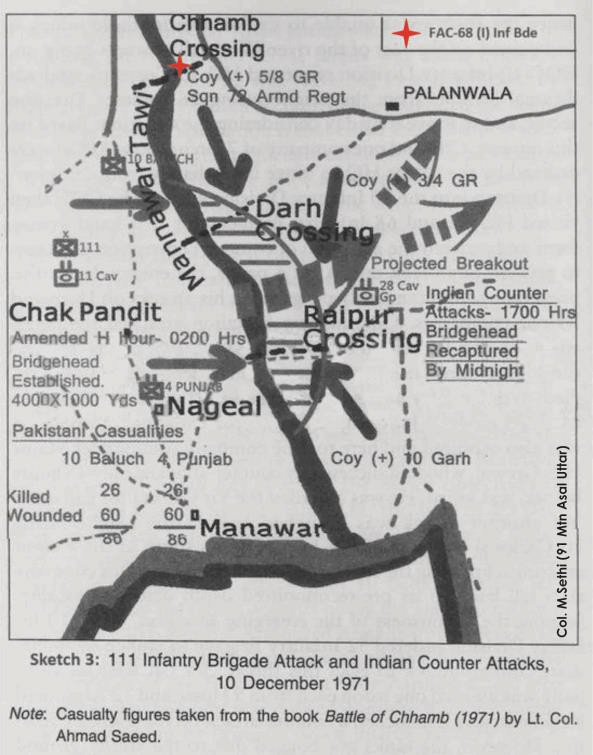
I quickly got the coordinates of target areas across both the Crossings on west bank and had Immediate Demands for CAS raised. I had a total of five CAS missions over the day against tanks, guns, vehs & troops concentrations in this area. In this operation, 72 Armd Regt, Deccan Horse & 52 Inf Bde were also directly involved.
Plt Offr Y (Yuri) Suri, my Course mate, was the FAC with 72 Armd Regt. As of now, I do not remember who was the FAC with 52 Inf Bde. In addition to the air effort directly allotted to these two formations, as per my records, at least another two missions of four S-22 aircraft each & one mission of two Hunters were also controlled by FAC 72 Armd / 52 Bde & struck the enemy forces in this crucial land battle! With a well defined Forward Line of Own Troops (FLOT); two prominent `funnel’ pts, good reference of Dhar & Raipur Crossings, appx two & four km (respectively) south of Chhamb bridge and a large concentration of enemy tanks & troops in the area (W of Tawi) presented good targets for the strike aircraft the whole day; and Indian Air Force with Sukhois from Falcon (101) Sqn & Hunters from Lightning (20) Sqn, loaded with 500 kg / 1000 pounder bombs, 64×57 mm Rockets / 68mm SNEB Rocket Pods with 19 rockets in each pod & 30mm guns caused massive destruction and thus played a decisive role in not only blunting the thrust but also forced the enemy to retreat from East of Manawar Tawi.
The defending 9 Jat troops were completely surprised with attack developing in the night & through tall sarkanda grass across the river. It later revealed that they did not have any surveillance element across the Tawi in this area. 9 Jats fought valiantly at both the crossings and repulsed the initial offensives but were overrun in the subsequent attacks. Maj Guleria, Coy Cdr (whom I had met on 04 Dec) & his Coy Subedar, at Dhar crossing, were captured, inhumanly tortured & brutally killed. RIP Brave Hearts. The enemy managed to ingress & establish a bridgehead of appx 3000 x 900 mtrs but their tanks got bogged down in marshy land opposite the crossing. With timely reinforcement & a counter-attack with tanks and infantry, the enemy’s advance was stalled & the Bridgehead contained.
However, in this counter-attack, some of our tanks (72 Armd Regt / Deccan Horse) also got bogged down. At both Dhar & Raipur Crossings, the quickly reinforced troops & the repeated airstrikes by IAF on the western bank caused heavy casualties & destruction on Pak’s subsequent build-up & stopped their momentum. Thus, before the last light, Pak troops were completely shaken, disorganized & were forced to pull back from East of Manawar Tawi. `Though, it was claimed to be a `miss reporting’ by Major Nazar Hussain, Brigade Major (BM) of Pak 111 Bde; but if he was to be believed, `by mid-afternoon, the attacking 28 Cavalry was down to Four tanks’; and at 1400 hours, the new GOC 23 Pakistani Division ordered the withdrawal of 111 Bde from East of Manawar Tawi’. (Reference: The Battle of Chamb-1971 by Maj (Retd) Agha Humayun Amin)
However unknown to Indian Army (GOC 10 Div), finally a two-pronged counter-attack by 5/8 GR, 7 Kumaon, 3/4 GR & 10 Garh Rif supported by armour was launched from North & South, along the eastern bank of the Tawi. It was only by midnight that the Pak forces were completely pushed back to West of the Tawi. In this attack, Pakis suffered very heavy casualties. In fact, the next morning, the whole area (East of Tawi) was found littered with bodies, indicating the intensity of the battle. Their six tanks were destroyed on the eastern side of the Tawi by our ground forces & one serviceable tank was also found abandoned.
Back at 5/8 GR location, on 10th Dec, around 1 pm, when we found a short lull in the air activity, we three (officers) decided to finish our packed lunch, in one trench. Soon, the firing restarted and one motor shell hit the bundh, just outside our trench and the tail unit fell inside. Yes, it was ‘close’; my ‘fourth’ in the week; but sure, our number was not up! The reaction was just to curse the Pakis, dust off the ‘purries’ & quickly finish the lunch! Once, the firing stopped, we were told that the jawan who had delivered us the lunch had been martyred; while, another three were wounded. I asked the driver to pull out our jeep & take the injured to the Bde Hqs. He informed that it was our FAC jeep which had got the direct hit, split into two and was on fire! My R/T operator & the driver too were lucky to be saved! Yes all, including the Satpal Light, went with the jeep! From the burning vehicle, we could only retrieve one wheel which I had borrowed from my friend, Yuri’s jeep!
On 11th Dec, five CAS missions of S-22s & Hunters were flown against tanks concentration & dug in troops opposite Dhar & Raipur Crossings (i.e. against the remnants of the en strike force / any further build-up), Chhamb village, Mandiala heights & Sukhtao nallah area (Appendix-C). The targets were pounded with bombs, rockets & guns. The same day, Lightning Squadron (20 Sqn) also flew a four aircraft dusk (just after sunset) `Path Finder’ mission to mark & illuminate a target area infested with extensive, enemy dug-in positions, just west of Tawi for our Canberras to come & plaster a few minutes later. The Hunters carried out an accurate napalm drop followed by a rocket attack. The Canberras neutralized the target seven mins later with 8000lbs of bomb load. The extracts from the Lightning Squadron records highlight strike details of eleven CAS missions (including one 4 aircraft Path Finder & a Canberra mission) flown by / in coordination with the Sqn, from 08th to11th Dec 71, in support of Battle of Chhamb.
After 11th Dec, though the regular exchange of ground fire went on from either side but the enemy did not attempt any offensive; and nor did our ground forces take any major action to carry the war across the river. On 12th no airstrike was carried out opposite our area; while on 13th Dec, the last mission of four Hunters attacked dug in troops & a few bunkers at Mandiala heights (Sukhtao nallah); but did not spot any tank in the area. Thus, the situation stabilized along Manawar Tawi.
In this Sector, our own surveillance elements & SF troops also carried out regular night raids across the border to bring in critical intelligence, cause destruction and / or inflict vital damage on enemy forces where tasked. I remember meeting two such valiant SF officers a few times at our ‘Sarkanda Mess’ in wee hours of the morning. They were well camouflaged from head to toe & equally covered with mud (knee deep), indicating the type of mission they would have gone through the previous night! On those dark nights, the howling sound of a jackal was mostly followed by arty shelling; & largely, it did not appear to be a coincidence! We also caught one Paki infiltrator from top of a banyan tree. After the brutal killing of Maj Guleria on the 10th, the blood was boiling and most young officers of the Bde wanted that the POW be handed over to them, at least for some time, to settle scores; but our Bde Cdr was very clear & firm; and handed him over to the Div Hqs for further action.
On 17th Dec, before the cease-fire (CF) came into effect on the Western Front, there was a Diwali of sort and both sides kept all triggers pressed till 2000h, the CF time; may be, no one wanted to carry the load back & get into audit counting!
Memories to Linger!
The above short narration is from the account of just one Brigade of 10 Inf Div! Sure, there would be many more untold stories of valour from the air as well as ground operations of other three Bdes & participating units!! During the complete duration of the war, as per the Bde records (my citation), I had a total of twenty missions. Though, as of now, I would not be able to state the total number of claims by the CAS missions but a few points do emerge!
➢ Whenever our aircraft came into attack, it raised the morale of our troops sky high!
➢ Apart from the one suicidal mission of two Sabres on 10th Dec which bounced our Hunter formation (& lost one Sabre in the air to air battle), after 06th Dec, there was not a single PAF aircraft seen or reported along the Manawar Tawi / in this area. Thus, it could be firmly said that IAF had gained & maintained complete air superiority over the tactical battle area (TBA) of 10 Div Sector till end of the war! Towards this aim, as per the official history of 71 War, IAF flew over two hundred
fighter / bomber sorties in support of our land forces in the Battle of Chhamb. Close coordination with the Army, purposeful execution of the task by all air warriors, including, the operational, maintenance & administration staff; and professional handling & the weapon delivery by the air crew contributed to the success achieved.
➢ Although, the grit & gallant performance of our soldiers & air warriors who fought fearlessly & many even laid down their lives; and valiant display of raw courage & leadership at all levels of many participating formations & Squadrons in the Battle of Chhamb have been widely documented but the performance of Lightning & Falcon Sqns need a mention!
a) `When a tally was compiled for Lightning Squadron (20 Sqn) at end of the war, the Sqn turned out to be the highest scoring unit in IAF during the 1971 conflict. Since its primary role was Counter Air Operations, the unit had a total of 13 enemy aircraft, including four C-130 Hercules, destroyed on ground & two F-86 Sabres were shot down in air combat. In the eight days of operational flying, during the war, the Sqn flew a total of 121 sorties, fired about 15,000 x 30mm rounds of cannon ammo, dropped about 17,000 lbs. of HE bombs, 1720 litres of napalm and 548 rockets at en tgts. For this impressive performance, the Squadron Commander, then, Wg Cdr (later Air Vice Marshal) CV Parker and Sqn Ldr RN Bharadwaj were awarded Maha Vir Chakra (MVC). Five pilots, including, Sqn Ldr Jal Maneksha Mistry (posthumous) (RIP Air Warrior), then Lt (later, Admiral, Chief of Naval Staff) Arun Prakash, Indian Navy & Fg Off BC Karambaya were honoured with Vir Chakra (VrC). The Sqn also earned two Vayu Sena Medals (VM), two Mentioned-in-Dispatches (MnD) & ten Commendations from the CAS/AOC’. (The above excerpt is from the article, `When Lightning Strikes’ by Mr Jagan Pillarisetti. In fact the author, in this article, has given a very gripping, narration of most strike missions! The daring strikes undertaken by all pilots speak volumes of their (IAF’s) professionalism, grit & leadership at all levels! Yes, an engrossing story!)
b) During the 1971 War, `The Falcons (101 Sqn) flew a total of 210 operational sorties on Sukhoi 7, striking airfields, ammo dumps and supporting the army. Major effort was in Chhamb Sector where sixty nine tanks, twenty heavy guns and fifty seven vehicles were destroyed. They emerged as the saviours of Chhamb and brought glory! Henceforth to be known as “Falcons of Chhamb”! In recognition of their magnificent contributions, the Falcons were honoured as the highest decorated fighter bomber Squadron during the Fourteen Day War with one MVC, one AVSM, eight VrCs, two VMs, one VSM and six MnDs’!
The above quote is engraved on the `Falcons of Chhamb, Indo Pak War Trophy – 1971’ (Appendix-F). The rank, name, award conferred, number of operational sorties flown / tanks destroyed & the role played by each Officer during those fourteen days of the War is also mentioned & can be read on enlargement!
➢ The above extracts, from the records of just two Sqns of IAF, also highlight the rightful thrust given by Indian air force to Counter Air Operations (i.e. against enemy airfields & aircraft on grd / in air) during the first three days of the war which paid rich dividends, initially in restricting & later severely limiting the war waging potential of PAF in this Sector!
➢ The intensity of enemy’s grd fire from AD weapons, in this sector, was high but it lacked in accuracy; which was made up by very high volume. Thus, a number of our strike aircraft returned with bullet holes. However, these aircraft were very expeditiously repaired, serviced & brought back on line by skilled maintenance staff of IAF; and soon participated in the War.
➢ IAF lost five aircraft in CAS role in Chhamb sector (Reference: IAF Aircraft Losses Database 1971 – www.bharat-rakshak.com).
➢ Two S-22 aircraft of 101 Sqn were lost to en ground fire on 04th & 06th Dec while attacking en positions South of Chhamb & near Munawar Tawi, respectively. Flt Lt Gurdeep Singh ejected over the battle field, near CFL (04th Dec); while; Flt Lt Jagdish Bhattacharya ejected in the en territory & in spite of spine injury managed to evade the enemy.
➢ Two S-22 aircraft (one each of 101 & 26 Sqns) along with their pilots (Flt Lt Vijay Kumar Wahi & Sqn Ldr Jiwa Singh) were lost on 06th & 07th Dec respectively, in two separate air combats, while returning after their successful missions in Chhamb sector.
➢ On 10 Dec, a Hunter aircraft of 27 Sqn, flown by Sqn Ldr Mohinder Kumar Jain, was hit by en fire in 28 Inf Bde sector & lost along with the pilot. RIP Air Warriors.
As is now widely recorded, in this war, India lost about 21,000 hectares of fertile agricultural land and Indian Army suffered maximum casualties in this battle. The total numbers of casualties were estimated at 1,353; which included, 440 killed, 723 wounded, and 190 missing & prisoners of war. The Pakistani losses were said to be about two to three times of our number both in men and equipment.
On 18th Dec, as we were getting mentally prepared to say bye-bye to our War Buddies & move back, I picked up a tank shell (empty) as a souvenir; & while, friend Yuri (now with Bollywood) was still looking around, my last 15 days’ neighbor quickly fired one round & offered the empty shell to him! Maj KB Thapa, Coy Cdr, D Coy, 5/8 GR presented me a Khukri which is still a prize procession of mine & finds a proud place in our house! My next stop was at the base of Kachrial heights; & sure, I found my watch, which I had lost during the en air strike on 04th Dec, lying at the same place, well coved in mud! On 19th / 20th Dec, while some of us were moving back to our Bde Hqs at Akhnur, en-route, we were greeted by our Bollywood star, Dharminder & his troupe with a truck load of sweets for the troops!
Finally, it was a few days before the end of 1971, when I picked up my revolver & 24 live rounds, kept in safe custody of the Bde armoury (for complete duration of the war) and bid final farewell to 68 (I) Inf Bde. During our journey back to Delhi, we got very emotional reception at every railway station; which we all ‘faujies’ fondly acknowledged!! Yes, with a well earned `Khukri’ hanging from one side of the belt, it was indeed a proud moment & my love for the uniform grew ever stronger and remained so-ever-after!!
Lastly, I do remember, when we returned to OTU, Jamnagar in Jan 1972, we were asked to write down our achievements; and if we still felt so strongly, forward it to Air Hqs! But by then, our priority had shifted to the successful completion of our Conversion rather than to keep looking back!! Yes, by then, we all of 106th Pilots Course were very happy, proud & content; and knew, that we were the Lucky Few who had carved their names in the history of 1971 War; and each one of us had earned for himself `his own personal video tape, permanently etched in his memory cells’ that would start auto display, at any small trigger, any time, throughout his life!!!
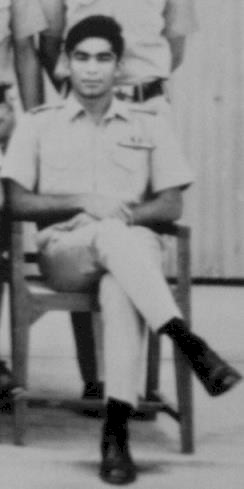 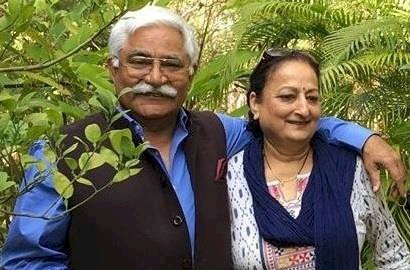 The Author – then Pilot Officer H K Bajaj (Left) from June 1971, and now as a retired Group Captain with Mrs Manju Bajaj in 2020 |
Gp Capt H K Bajaj, VSM superannuated from IAF after 32 years of service. He has appx 3000 hrs of accident free flying experience on single-engine aircraft. He is an A2 QFI, has flown Hunters, S-22 & Mig 23 (BN) ac. He raised & Commanded an OSA-AK (M) missile Sqn, was Chief Operations Officer at AF Station Halwara and attended Higher Command Course at College of Combat, Mhow. He Commanded AF Station Rajokri from 1996-99 and was last posted as SI at DSSC, Wellington from 1999-2003.
© Text and Images are the Copyright of the Author. All Rights Reserved. Reproduction in whole or in part in any form or medium without express written permission of Gp Capt HK Bajaj is prohibited.
References / Notes:
1. 1971 War: Memories of the Chamb Battle – By Lt Gen Baljit Singh
2. 1971 War: Battle of Chhamb – By Maj Gen Sukhwant Singh
3. 1971 Operations – Case West – I. By Major K.C. Praval
4. IAF COMBAT KILLS – 1971 INDO-PAK AIR WAR – Author: B. Harry
5. Mission to Chamb – Written by Gp Capt Apram Jeet Singh VrC (Retd)
6. INDO-PAK WAR 1971 – VICTORY REVISITED Issue: 1 / 2012 By Air Marshal (Retd) V.K. Bhatia
7. Official History of 1971 India Pakistan War – IAF in the West. – Bharat Rakshak India
8. Close Air Support – Chammb Sector. Mission Report – 10 Dec 71 By Wg Cdr (then Fg Offr) BC Karambaya, VrC (Retd)
9. Extracts from the War Diary of Lightning Sqn – Close Air Support, Chhamb 71 By then, Lt (later, Admiral, Chief of Naval Staff) Arun Prakash, Indian Navy. Submitted by Wg Cdr (then, Fg Offr) BC Karambaya, VrC (Retd)
10. When Lightning Strikes! – Written by Jagan Pillarisetti
11. IAF, IA & IN Aircraft Losses Database 1971 – www.bharat-rakshak.com
12. The Battle of Chamb – 1971 by Maj (Retd) AGHA HUMAYUN AMIN
13. TRISHUL: Why CHHAMB Continues To Matter … trishul-trident.blogspot.com
14. Ejected over No Man’s Land! By Gp Capt (then Flt Lt) Gurdeep Singh (Retd)
15. Ejected over No Man’s Land! – The view from the other side! By Major General Syed Ali Hamid (Retd)
16. Pocket Diary of 71 War of then Plt Offr HK Bajaj Submitted by Gp Capt (then Plt Offr) HK Bajaj (Retd)
=====================================================================================
Acknowledgements: PVS Jagan Mohan, Anchit Gupta and Wg Cdr BC Karambaya, Vr C (Retd), Gp Capt Gurdeep Singh (Retd) and Colonel M Sethi (Retd)
=====================================================================================
Appendix A:
One Inch Map belonging to the Indian Army – this was recovered by the Adjutant of the 28 Armoured Div of the Pakistan Army, Major Syed Ali Hamid (Later Major General). The Red Circles show the location of IAF aircraft that have been lost during the operations. From North to south, they refer to the locations of aircraft flown by Sqn ldr M K Jain, Sqn Ldr Denzil Keelor and Flt Lt Gurdeep Samra.
Appendix B
Extract 06 and 07 December from Pocket Diary of Plt Offr H K Bajaj
6th December
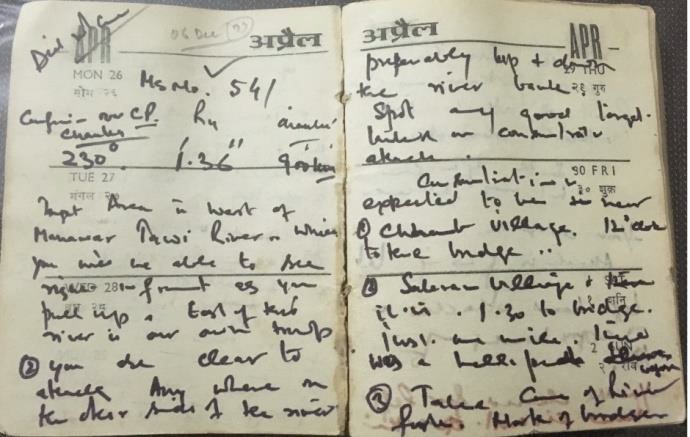
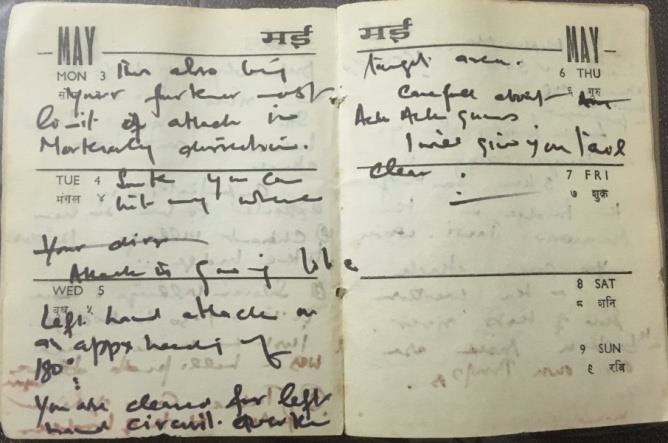
7th December
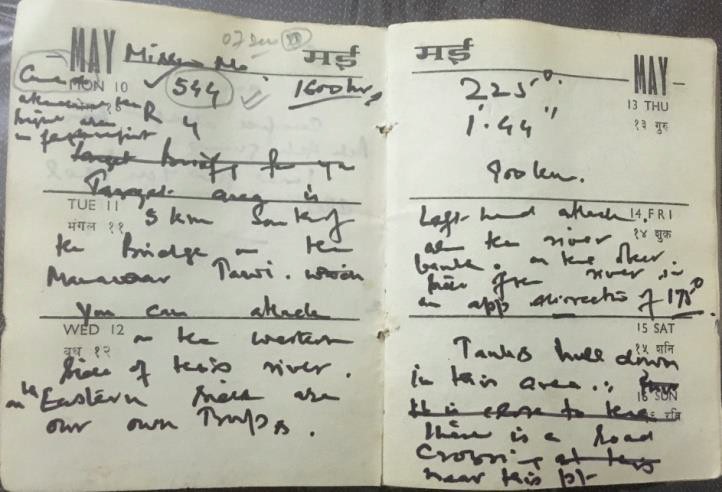
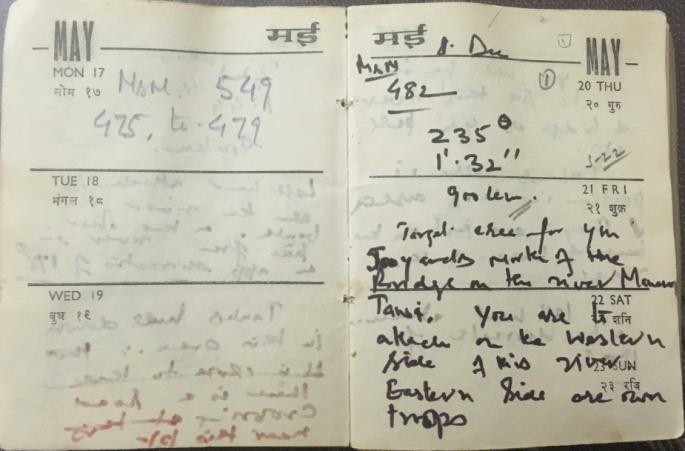
Appendix C
Extract 09 and 11 December from Pocket Diary of Plt Offr H K Bajaj
9th December
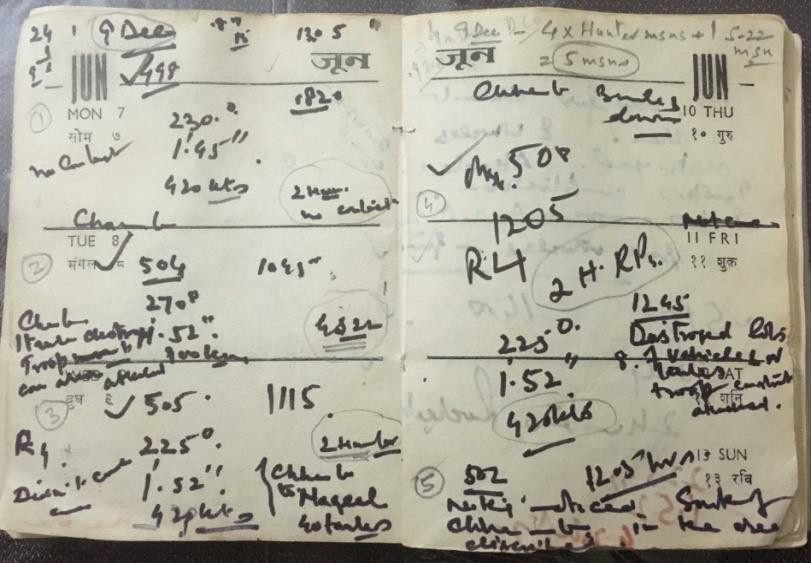
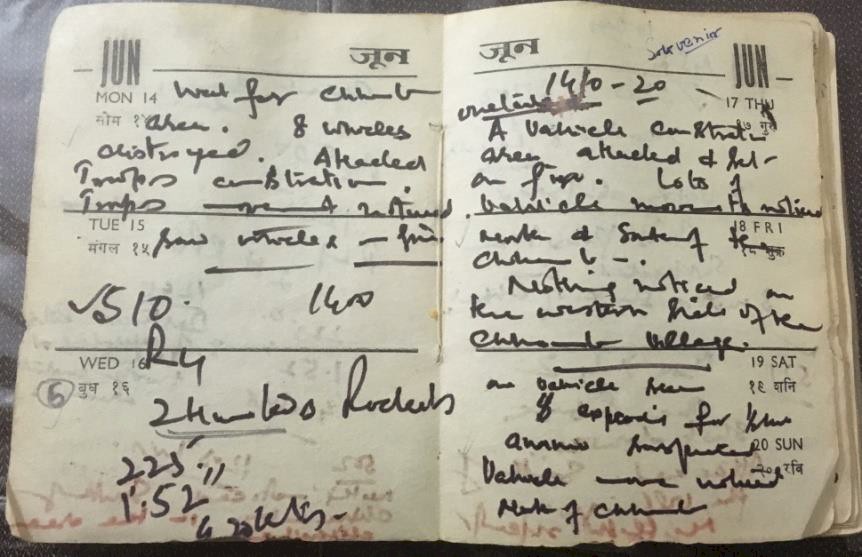
11th December
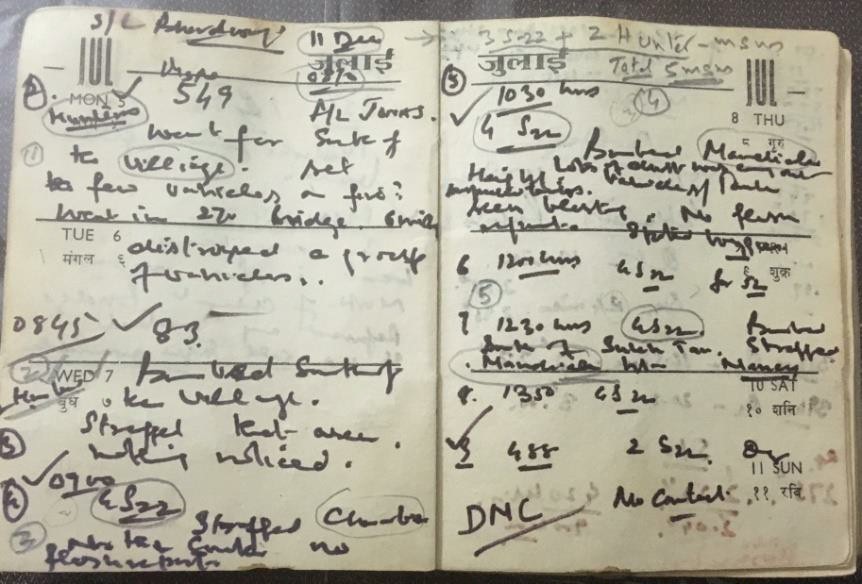
Appendix D
CLOSE AIR SUPPORT – CHAMMB SECTOR MISSION REPORT-10 Dec 71 by Wg Cdr B C KARAMBAYA VrC (Retd)
No 20 Sqn, based at Pathankot, was tasked to provide close air support to the Army in Chammb Sector, as our troops had been pushed to eastern banks of the Munawar Tawi.
Sqn Ldr R N “Mummy” Bharadwaj and self were detailed for this sortie by the CO, WgCdr C V Parker; Time over Target (TOT) was at 0730 hrs on 10 Dec 71. The aircraft was loaded with full HE ammo for front guns, 230 gal inboard drop tanks on the inboard pylons and SNEB Rocket Pods, with 19 rockets in each pod, on the outboard pylons.
Mummy and self were briefed by the GLO, IP was selected. Further briefed by Ops room that we were to contact the FAC ‘Linda Control’ by giving an R/T call without our mission number or any other info. If the FAC responded by giving our mission number, we were to proceed on our mission. If any other R/T call was given by the FAC, we were to return.
We came back to the Squadron, prepared our maps and Mummy briefed that we would fly at 500 ft AGL at 360 Knots (kts) till IP in line abreast formation and then accelerate to 420 kts to the target.
We went to our aircraft, which was loaded and ready; started and took off as per plan. I got into 800 yds, line abreast position. After flying for about 10 mins, we started to enter the morning mist haze and visibility had reduced drastically. I moved into starboard fighting and I saw Mummy giving me thumbs-up sign.
We reached the IP and accelerated to 420 kts and Mummy on r/t called, ‘Linda Control’; and we got a correct response of our mission number. The FAC told us “Seek and destroy at will, troops and tanks concentration in Chammb Village”.
We reached the target area and the FAC called up and said we were over the correct area. Mummy threw in a left hard turn and entered into a left orbit. I had a tough time holding starboard fighting position, scanning for enemy aircraft and looking for tanks / troops concentration. I informed Mummy that I was dropping back into a circle of joy position, which he okayed.
We were orbiting at 420 kts, height at about 300-500 ft AGL. During one such orbit, passing a westerly heading, I saw a small rivulet from the Tawi flowing westwards and in this rivulet, I saw two tanks and three open trucks with long crates in them, possible ammo for the tanks.
At this moment in time, three things happened simultaneously, I took my eyes off the tanks, to look for Mummy, when a Sabre flew between us and then I gave a call to Mummy ‘ Sabres in between, hard port, GO ‘ Instantly, I looked for the No. 2 Sabre and there he was climbing in the mist haze, 300 yds from me, firing his six cannons at me.
I took off bank, or I would have flown into his full salvo. He whizzed past me, Meanwhile Mummy gave a call that he had no visual contact with me. I told him that I had been hit and streaming fuel. My aircraft’s leading-edge was punctured and so was the port 230 gall drop tank, both streaming fuel.
I was now flying a northerly heading and suddenly I remembered “where is the No 1 Sabre’. I looked to my right and behind and there he was, 20 degrees angle off and about 400 yds, I gave a call to Mummy that I had a Sabre on my tail but he still had no visual contact with me. I threw in a hard starboard and I could feel his bullets hitting me on my tail and rudder. I then decided to climb slowly, to get out of the mist haze and not drop my speed below 350 Kts. I continued in a right orbit and whenever the Sabre got into a firing position I would turn tight, with two notches of flaps and he would slip out.
I continued turning, climbing and turning tight as and when the Sabre got into a firing position. I cannot recollect how many orbits I must have done but at about 5000 ft, indicated, we came out of the mist haze. I was also talking to Mummy all this time and then Mummy called he had visual contact with me 3000 yds, starboard, closing in. I told Mummy I am disengaging and heading eastwards diving, to which he said OK.st
On a 090 degree heading, I put the aircraft into a steep dive, fired the rockets pods randomly to reduce the drag. In the rearview mirror, I could see the Sabre falling behind. I saw a hill feature and dived straight for it and at the last moment jinked to the right to avoid it and levelled out at deck level. Again in the rearview mirror, I could not see the Sabre. I think I lost him.
I then changed course on DR for base and with help from ATC and the SU at Amritsar, I landed back safely at Pathankot. I did not jettison my drop tanks & was never on fire. On switching off and inspection of the aircraft I found that I had been hit on the leading port edge, 230 gal drop tank left and right side of the rear fuselage and rudder. Later, the Tech team did bring to me a couple of ball ammo bullets taken from the engine casing.
Further; to Mummy’s version:
After he spotted me streaming fuel, he started to close in when he saw me starting to dive and saw the Sabre following. When I jinked at the hill feature, he saw the Sabre turning port; presumably, he lost me and decided to head back to his country. Mummy closed in rapidly and at a very high overtaking speed and at about 400 yds, cross on the Sabre, he opened fire. The Sabre disintegrated and Mummy flew through the debris. On seeing his film on normal speed, we can see the full Sabre and next moment you are covering your head when you see the debris flying past.
Appendix E:
Extracts from the War Diary of Lighting Squadron – Close Air Support
Coming Soon
Appendix F:
FALCONS OF CHHAMB
INDO PAK WAR TROPHY 1971
Submitted by Gp Capt (then, Flt Lt) Gurdeep Singh (Retd) of Falcons of Chhamb (101 Sqn)
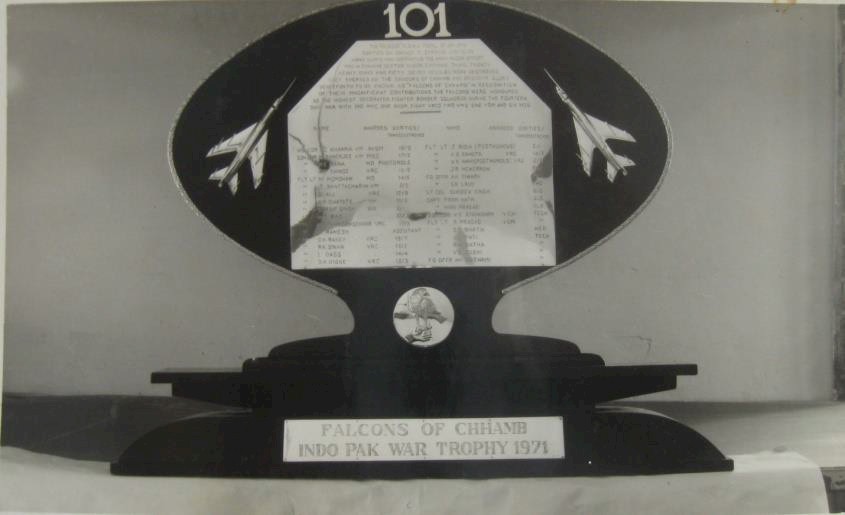
(Engraved on the Trophy)
`THE FALCONS FLEW A TOTAL OF 210 (?) OPS
SORTIES ON SUKHOI 7 STRIKING AIRFIELDS,
AMMO DUMPS AND SUPPORTING THE ARMY. MAJOR EFFORT
WAS IN CHHAMB SECTOR WHERE SIXTY NINE TANKS, TWENTY
HEAVY GUNS AND FIFTY-SEVEN VEHICLES WERE DESTROYED.
THEY EMERGED AS THE SAVIOURS OF CHHAMB AND BROUGHT GLORY.
HENCEFORTH TO BE KNOWN AS “FALCONS OF CHHAMB”. IN RECOGNITION
OF THEIR MAGNIFICENT CONTRIBUTIONS THE FALCONS WERE HONOURED
AS THE HIGHEST DECORATED FIGHTER BOMBER SQUADRON DURING THE FOUTEEN
DAY WAR WITH ONE MVC, ONE AVSM, EIGHT VrCs, TWO VMs, ONE VSM AND SIX MnDs.’
